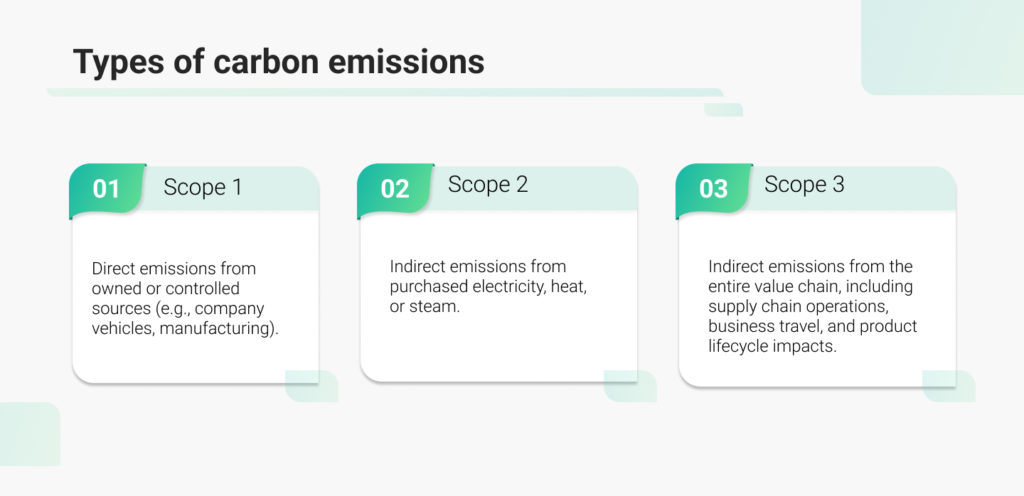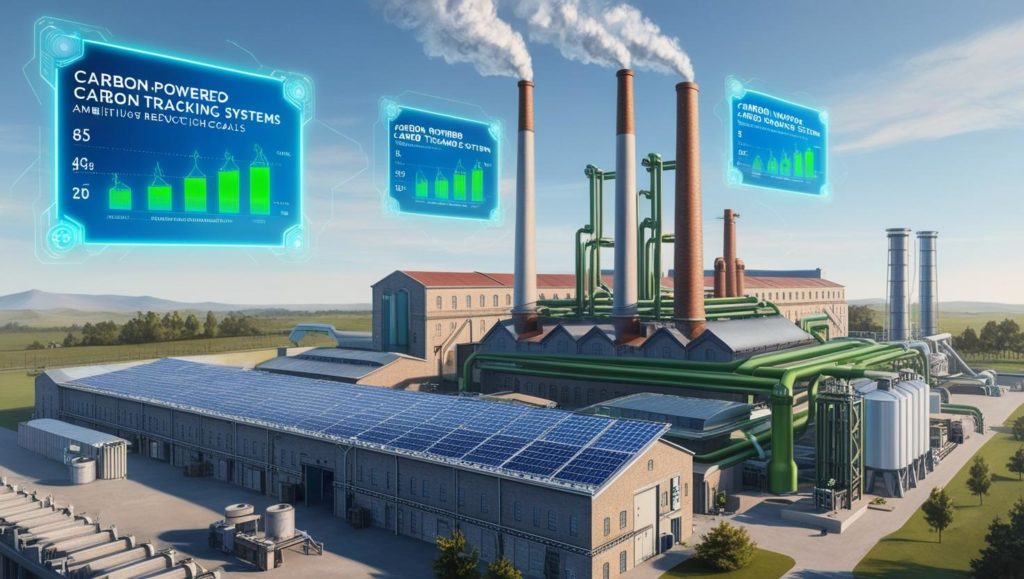Once driven solely by cost and efficiency, industries now face a new reality—climate change is reshaping economies, supply chains, and investments. As world leaders push for lower carbon emissions, carbon accounting has become essential in tracking and managing environmental impact.
According to IPCC, The industrial sector accounts for about 30% of global greenhouse gas (GHG) emissions, making carbon accounting crucial for mitigation. Though carbon accounting is the new buzzword of the industry, in reality, it is a solution to understand the amounts of pollution emitted by industries in the form of greenhouse gases.
Carbon accounting is like keeping a report for pollution caused by businesses and industries. It measures how much carbon dioxide (CO₂) and other greenhouse gases are released into the air. These gases trap heat and make the planet hotter, leading to climate change. By tracking these carbon emissions, companies can find ways to reduce pollution and follow government rules. This helps protect the environment, save energy, and build a greener future.
What is Carbon Accounting and Why Does It Matter?
Carbon accounting, also known as GHG accounting, is the process of measuring, tracking, and managing greenhouse gas (GHG) emissions from businesses, industries, and regions. It plays a critical role in addressing climate change by identifying sources of emissions and enabling strategies to reduce them. Since GHG emissions trap heat in the atmosphere, they directly contribute to rising global temperatures, extreme weather events, and environmental degradation. By implementing carbon accounting, organizations can take informed steps toward mitigating these impacts.
Beyond environmental responsibility, carbon accounting is becoming a strategic business necessity. It helps companies meet sustainability regulations, attract ESG-focused investors, enhance brand credibility, and stay competitive in an increasingly eco-conscious market. With 92% of the global GDP now committed to net-zero targets by 2050, businesses that fail to track and reduce emissions risk falling behind regulatory and investor expectations. Effective carbon accounting not only supports compliance but also strengthens long-term profitability and risk management.
The Greenhouse Gas (GHG) Protocol provides a structured framework for carbon accounting, categorizing emissions into three scopes:

- Scope 1: Direct emissions from owned or controlled sources (e.g., company vehicles, manufacturing).
- Scope 2: Indirect emissions from purchased electricity, heat, or steam.
- Scope 3: Indirect emissions from the entire value chain, including supply chain operations, business travel, and product lifecycle impacts.
Leading organizations like Microsoft have embraced carbon accounting as a core part of their sustainability strategy. The company aims to become carbon-negative by 2030 and tracks emissions across all three scopes. By implementing an internal carbon fee—charging business units based on their emissions—Microsoft integrates sustainability into financial decision-making, setting a strong example for corporate climate action.
With climate risks escalating, carbon accounting is no longer optional—it’s a fundamental tool for businesses to drive sustainability, manage risks, and contribute to a low-carbon future.
Why Carbon Accounting is a Corporate Imperative
Climate change isn’t just an environmental issue—it’s a business risk. Companies are not only morally responsible for their emissions but also face increasing pressure from investors, regulators, and customers to take action. Following carbon accounting protocols can unlock better investment opportunities, enhanced brand reputation, and stronger client relationships.
A PWC report reveals that over 90% of institutional investors consider ESG factors, including carbon accounting, when making investment decisions. By leveraging carbon data to develop emission reduction strategies, businesses can align with sustainability regulations while improving transparency and credibility.
Additionally, carbon accounting ensures compliance with the Greenhouse Gas (GHG) Protocol, a globally recognized standard used by over 92% of Fortune 500 companies to measure and manage their emissions. In today’s market, integrating carbon accounting isn’t just about sustainability—it’s about securing long-term business success.
Advantages of Carbon Accounting for companies
There’s a twin advantage for businesses adopting carbon accounting – apart from being a tool to tackle climate change, it gives businesses a strategic edge, which can help dominate in their industry. These advantages can significantly drive sales, growth and even spur investments.
- Increased Corporate Value:
According to a report published by IBM, 77% of consumers would be more inclined to brands who are sustainably and environmentally responsible. Using Carbon Accounting can help businesses attract more clients or sales. It can also help avoid labels like ‘greenwashing’, which is essentially considered as a negative connotation for businesses.
IKEA has embedded carbon accounting into its entire business strategy. By focusing on reducing its supply chain emissions and increasing the use of renewable energy, the company has cut its carbon footprint by over 20%. This transparency in reporting has strengthened customer trust and brand loyalty.
2. Reduction of risks:
A business has to face multiple risks including compliance, financial and market risks.
Carbon Accounting can help companies mitigate and assess several risks related to climate change sector. It can help avoid compliance risks by environmental monitoring and reporting, staying ahead of all the regulatory and policy frameworks. It can also reduce operational risks by analyzing and predicting upcoming disruptions in the world.
For Example: By evaluating supply chain risks linked to climate change using carbon accounting, Unilever helps to avoid interruptions in raw material procurement, including palm oil and cocoa.
3. Decrease in Business Costs:
At first, adopting carbon accounting may seem like an extra cost for the business, but in the long run, carbon accounting can significantly help in decreasing various associated costs of business and save money.
For Instance, according to a report by McKinsey, Organizations employing systematic carbon management achieve energy savings of up to 20%, hence decreasing operational expenses.
By identifying significant sources of carbon emissions, businesses can optimize energy usage, resulting in lower utility expenses and overall cost savings through carbon accounting.
For Example, Walmart saved $1 billion in five years by optimizing its supply chain’s carbon footprint.
5 Essential Steps to Start Carbon Accounting
Implementing carbon accounting is crucial for businesses aiming to track, reduce, and report their greenhouse gas (GHG) emissions. A well-structured approach ensures compliance with global sustainability standards and improves corporate reputation. Here are the five key steps to get started.
1. Define Your Emission Boundaries
Before measuring emissions, businesses must establish their organizational boundary—the operations and activities under direct control. The GHG Protocol categorizes emissions into three scopes:
- Scope 1: Direct emissions from owned sources such as company vehicles and manufacturing processes.
- Scope 2: Indirect emissions from purchased electricity, heat, or steam.
- Scope 3: Indirect emissions from the value chain, including suppliers, transportation, and product lifecycle impacts.
For example, a direct-to-consumer (D2C) company may prioritize Scope 3 emissions, such as supplier emissions, product transportation, and end-user impact. In contrast, a manufacturing company may focus more on Scope 1 emissions from its production facilities.
2. Choose the Right Reporting Standards
Businesses must align their carbon accounting with recognized global and regional frameworks to ensure compliance and credibility:
- Global Standards: GHG Protocol, ISO 14064, CDP (Carbon Disclosure Project), TCFD (Task Force on Climate-related Financial Disclosures), SBTi (Science-Based Targets Initiative).
- Region-Specific Standards: EU CBAM (Carbon Border Adjustment Mechanism), India’s BRSR (Business Responsibility and Sustainability Reporting), SECR (Streamlined Energy and Carbon Reporting in the UK).
Selecting the right framework depends on the organization’s operational scope, industry, and regulatory requirements.
3. Plan Workforce and Expertise Needs
Carbon accounting requires specialized expertise, and businesses need to determine whether to build an internal sustainability team or outsource to external specialists.
- In-house Team: Companies with long-term sustainability goals can develop an internal team with trained professionals.
- Third-Party Consultants: Small businesses or those new to carbon accounting can benefit from external ESG consultants who bring expertise without requiring a full-time team.
For organizations with limited in-house expertise, outsourcing carbon accounting to specialists ensures accuracy and compliance while reducing the burden on internal teams.
4. Establish a Data Collection Framework
Accurate carbon accounting depends on a structured and reliable data collection process. Businesses need to:
- Identify relevant data sources, such as energy bills, fuel usage, procurement records, and transportation logs.
- Determine collection frequency, whether real-time, quarterly, or annually.
- Standardize reporting formats to maintain consistency and accuracy.
A well-defined data collection framework ensures that emissions tracking is efficient, reliable, and aligned with global reporting standards. Automating data collection can further reduce errors and improve efficiency.
5. Invest in Carbon Accounting Software
Manually tracking emissions is time-consuming and prone to errors. Carbon accounting software streamlines the process by automating data collection, tracking emissions, and ensuring compliance with international standards.
Key features of an effective carbon accounting platform include:
- Automated data gathering from operational records, fuel usage, and energy bills.
- Business system integration with ERP, IoT devices, and utility providers.
- Real-time monitoring and emissions trend analysis.
- Compliance with international reporting frameworks such as ISO 14064, CDP, and GHG Protocol.
Google has been carbon-neutral since 2007 and aims to operate on 24/7 carbon-free energy by 2030. The company’s carbon accounting strategy includes purchasing renewable energy, optimizing energy efficiency in data centers, and investing in sustainable AI-driven solutions.
How TSC’s NetZero helps enterprises with carbon accounting?
Avoiding common pitfalls is essential for maintaining a successful, compliant, and precise carbon accounting system. As emission regulations become more stringent, investing in the right carbon management software ensures accuracy, compliance, and a competitive edge. The Sustainability Cloud provides a robust solution for tracking and auditing Scope 1, 2, and 3 emissions in alignment with GHG Protocol and PACT standards.
With automated reminders, continuous monitoring, and enhanced transparency, the software streamlines carbon reporting and keeps businesses ahead of regulatory changes. With TSC, companies can seamlessly meet compliance requirements while advancing their sustainability commitments—paving the way for long-term growth and success.




